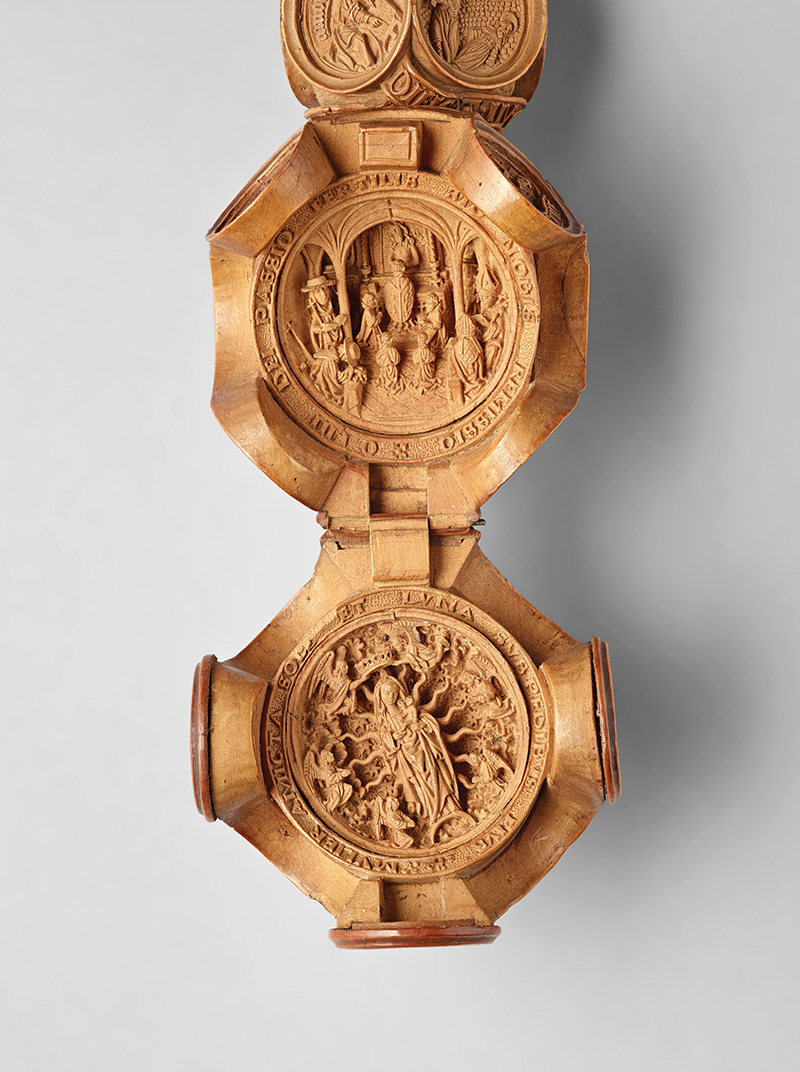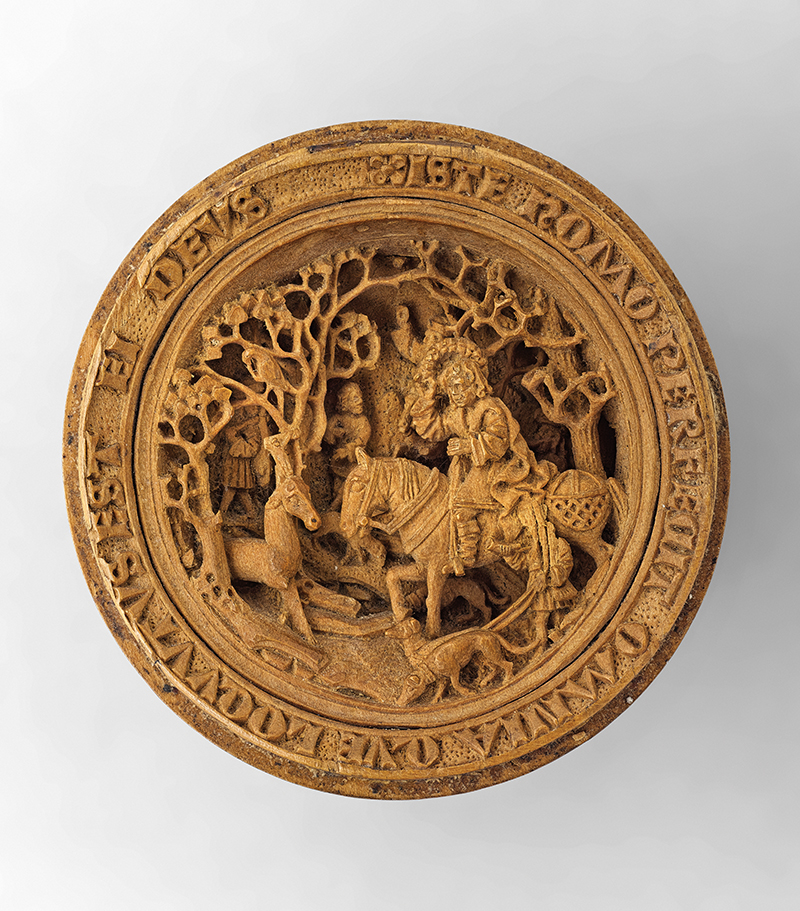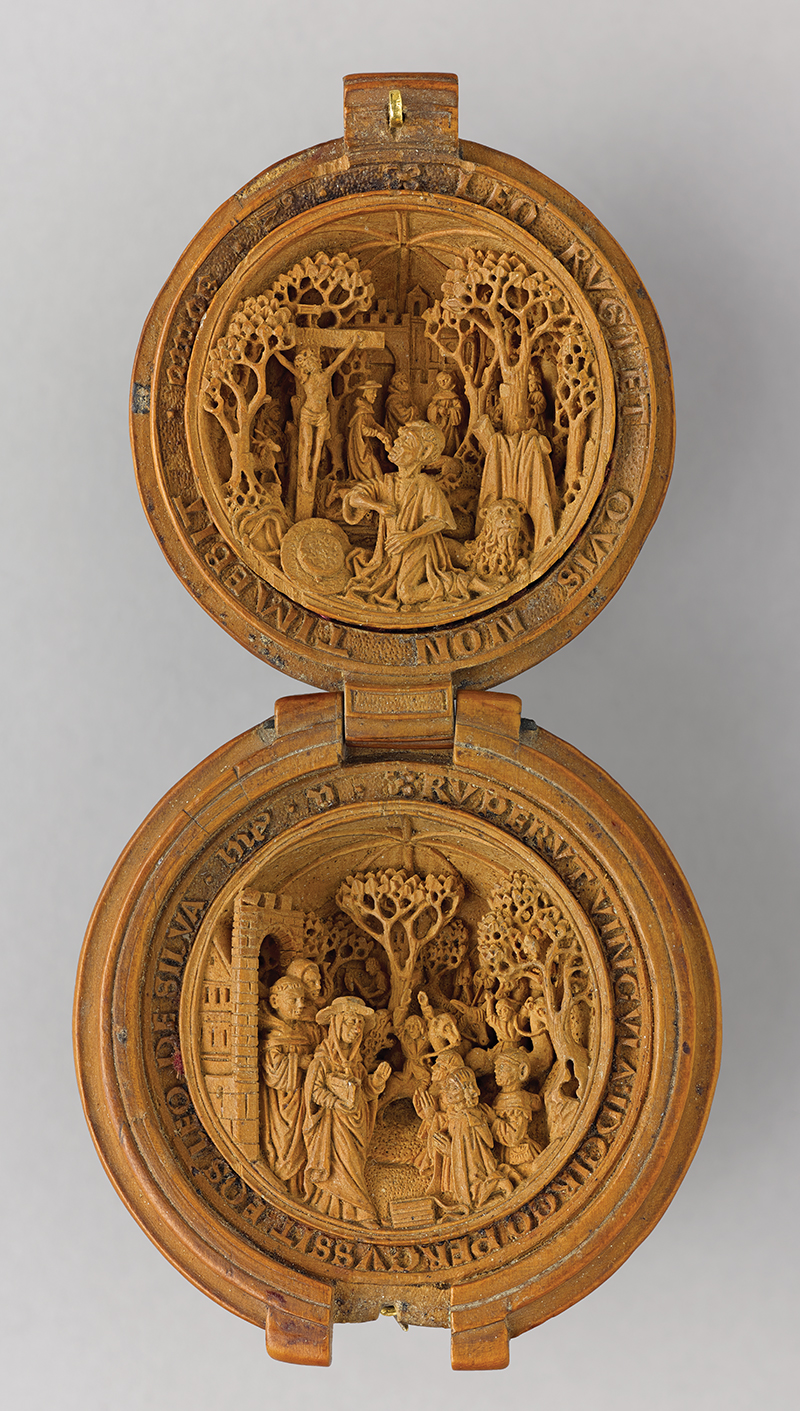The scenes and inscriptions of boxwood prayer beads attest unequivocally to the religious motivation of their original owners. Similarly, their size and shape speak to their primary function as objects that facilitated private prayer. Prayer beads fit perfectly in the palm of the hand so that their user could hold them easily, open or closed, and draw them close to view in detail. Rosary beads, used by Christians to count their prayers, were the likely inspiration for carved boxwood prayer beads. A wooden sculpture of St. Barbara shows a rosary hanging from the saint’s belt. Her rosary appears to include a gothic boxwood prayer bead.

A carved boxwood decade rosary given to King Henry VIII (1491–1547) and his first wife Catherine of Aragon (1485–1536) is much like the one worn by St. Barbara. A decade rosary consists of ten ave beads, each of which represents a single Ave Maria or Hail Mary prayer and one paternoster bead representing a single Our Father prayer. Typical of decade rosaries, its intricately carved ave beads are smaller in scale than its grand paternoster. Inside the upper half of the paternoster bead, a cardinal can be seen kneeling in prayer with a similar rosary in hand. And in the background, behind the freestanding column and visible only through CT imaging, a man and a woman witness the mass taking place at the altar from a gallery above. While dressed in contemporary Flemish fashion, this is no ordinary couple. It is likely that they represent Henry VIII and Catherine, whose initials are carved, together with the Royal Arms of England, on the exterior of the same bead. Accordingly, both the cardinal and the royal couple are linked to the central sacrament of the Christian church and to the praying of the rosary.

Even modest prayer beads make reference to rosary devotion, such as one with a kneeling nun holding prayer beads in her own hand in The Met’s collection (MMA 17.190.457a). Nestled within the bead, in close proximity to the Virgin and Child, the nun’s association with the holy couple is intimate and direct. Framing them is a narrow band for an inscription that, surprisingly, uses only part of the available space, reading simply: “O mater dei memento mei” (O mother of God, remember me). This is a humble supplication that petitions the Virgin Mary directly. In fact, when praying the Hail Mary with the aid of a rosary, it was thought that each prayer was transposed into a rose that the Virgin wore in a wreath on her head: with each prayer another rose was added—the more prayers, the more roses, the more luscious the wreath. [41]
A similarly modest prayer bead in the Thomson Collection also appeals to the Virgin (AGO 29362). An inscription framing the Annunciation in the upper hemisphere serves as a caption to the scene: “Virgo hvmilis verbo vitam dedit atgve saltem” (Humble virgin his word gave you life and salvation). The lower inscription distills the biblical account of the Nativity down to an essential detail that any woman who had suffered the pains of childbirth could understand as a miracle: “Hic miro more virgo parit absqve dolore” (The Virgin gives birth without pain in this wonderful manger). A prayer bead that depicts the Carrying of the Cross (also known as the Way to Calvary) and the Lamentation (AGO 29364) pictures the Virgin kneeling over her dead son in prayer. With eyes closed and a furrowed brow, the Virgin’s suffering is palpable.

Prayer Beads and the Personal
In some cases, the prayer beads do not refer to the lives of Mary or Jesus but instead picture individual saints. Three surviving prayer beads, including one in the Thomson Collection (AGO 29360), illustrate scenes from the life of St. Jerome, while other saints are found in only one or two examples. The Thomson Collection contains one half of a prayer bead that presents St. Hubert on horseback accompanied by an attendant who leads hunting dogs as he sounds a horn (AGO 29359). St. Hubert (born 705) was the patron saint of hunters and knights. The inscription that runs around the circumference of the bead reads “Iste homo perfecit omnia qve loqvvtus est ei deus” (This is he who lived according to God’s word). After Hubert’s wife died in childbirth, he turned away from the church and spent his time hunting in the woods. This scene depicts the moment when Hubert made eye contact with a stag that he was about to capture. In this moment, the image of a cross with Jesus upon it appeared between the antlers of the stag. In response, Hubert became a devout Christian who promptly renounced his wealth and titles. It is possible that the original owner was himself a hunter and that the subject was chosen for that reason. More likely, the choice is a reflection of the widespread devotion that Hubert enjoyed—and enjoys still today—in present-day Belgium and the Netherlands. This included the creation of the chivalric Order of Saint Hubert on Good Friday, 1445, [42] perhaps an additional connection of such beads to Holy Week and Good Friday observations.

Only one surviving prayer bead depicts key moments in the story of the biblical king David (AGO 29361). This multi-part prayer bead is comprised of wings flanking its upper half and a disc folding out of the bottom half. In the upper central scene the young David heroically beheads Goliath; below, David kneels before the prophet Samuel, who anoints him at God’s command. In the Middle Ages, David was considered one of the Nine Heroes, legendary men who personified the ideals of chivalry. The scenes on this prayer bead serve as reminders of the divinely ordained obligations of rulers. It is possible that this bead was made for a leader who aspired to be an ideal ruler.
A carved medallion in The Met collection (MMA 17.190.471) tells the story of a strong Old Testament woman. Esther is shown presenting her husband, the Persian King Ahasuerus, with a sumptuous feast. During the course of the meal, Esther successfully convinces Ahasuerus not to hang her cousin Mordechai who Ahasuerus felt had not paid him proper respect.
Miniature Altarpieces
The carved boxwood altarpieces functioned similarly to the beads, facilitating private prayer for their owners. Like large winged altarpieces that furnished churches in medieval and Renaissance churches across Europe, most of the miniature altarpieces have wings that close. The miniature altarpieces often include cavities to hold relics—the remains of a venerated person or saint. An astonishingly intricate triptych in The Met’s collection (MMA 17.190.453) includes a small receptacle for relics that is covered by a hinged disc. The triptych depicts the Crucifixion, a popular scene in large altarpieces at the time, in chaotic detail: half a dozen men on horseback and one donkey swirl beneath Jesus, while a simple, declarative inscription reads “Christ passus est [pro] nobis.” (Christ suffered [for] us). Below, Jesus bursts from his tomb on Easter morning, as the clueless Roman soldiers who guard him are deep in sleep. Like the triptych’s main scene, the small image below is flanked by tiny wings. The owner of the triptych would have opened and closed the wings to reveal the images inside. At least one miniature boxwood altarpiece survives with its original case, which would have been used for safekeeping.

Notes
[41] See Winston-Allen 1997.
[42] D.J. Dacre Boulton, The knights of the Crown: the monarchical orders of knighthood in later medieval Europe 1325–1520 (Woodbridge, Boydell Press, 1987), 605.